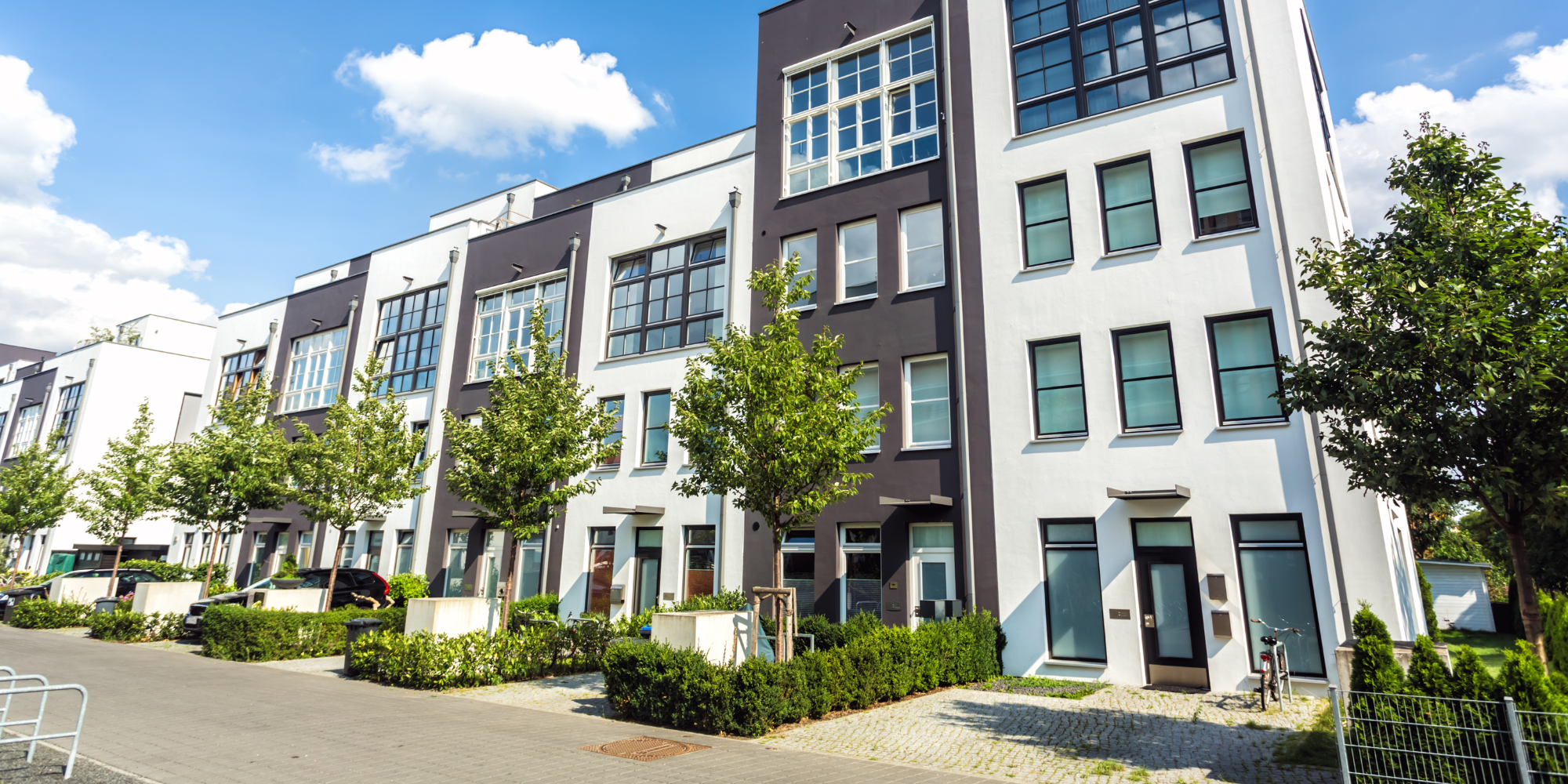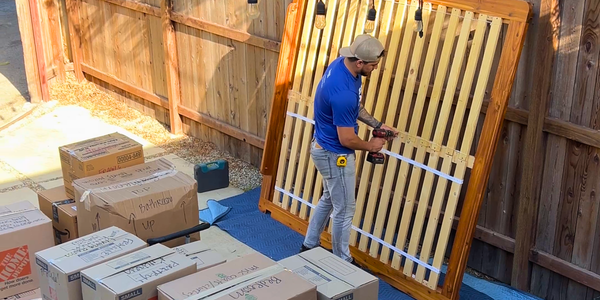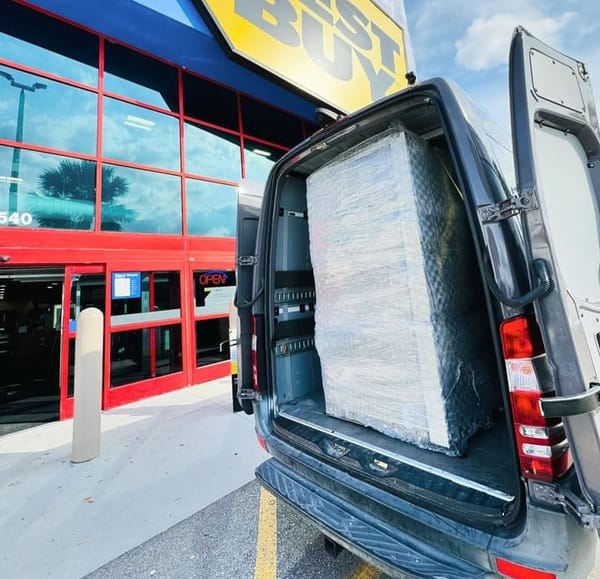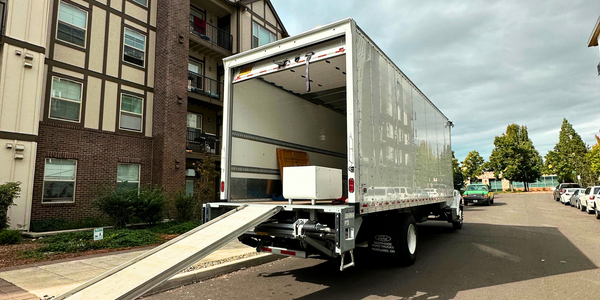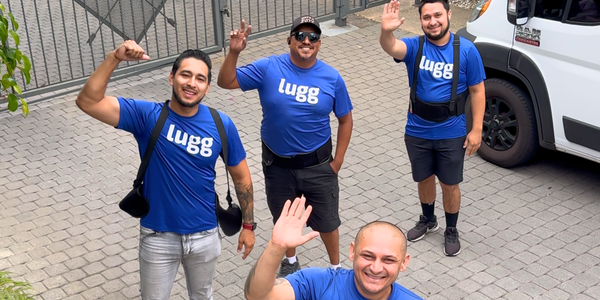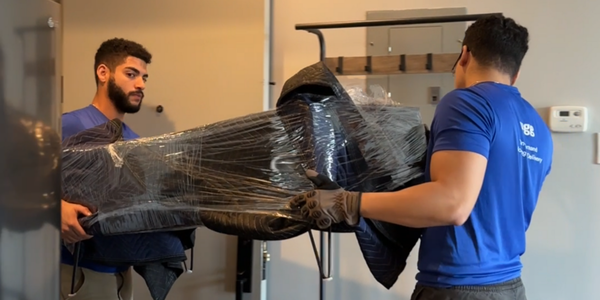Moving into your first apartment? Here's everything you need to know — from budgeting and apartment hunting to moving day and furniture delivery.
Getting your first apartment is exciting — and overwhelming. No matter if you’re moving out of a dorm, leaving a shared space, or finally taking the leap to live on your own, there’s a lot to figure out. From knowing what you can afford to actually getting your stuff through the door, this guide covers everything you need to know.
Finding your first apartment



Image 1: Side view of a modern apartment building | Image 2: Getting the keys to your new place | Image 3: Interior of a modern apartment
Step 1: Know your budget
Wondering how much you should spend on rent for your first apartment? Well before you fall in love with an exposed brick one-bedroom with vaulted ceilings, take a minute to run your numbers.
Most experts recommend spending no more than 30% of your monthly income on rent when getting your first apartment. Some landlords may also require proof that you make 3–4 times the rent, depending on the location and type of rental property.
But rent is just the beginning. Be sure to factor in:
- Utilities (if not included in rent)
- Internet
- Renter’s insurance
- Move-in fees or deposits
- Parking, pet fees, and other hidden costs
Not sure where to start? You can usually get quotes from service providers or look up average costs in your area for a rough estimate.
And if the math isn’t mathing, consider splitting expenses with a roommate or applying with a cosigner to meet income requirements.
Tip: Google average rent or utility costs in your city to get realistic estimates for your area.
Step 2: Figure out what you want (and what you can live without)
What should you look for in your first apartment — and what can you live without? Once you’ve set your budget, start narrowing down what you're actually looking for. Some features might be non-negotiable — others, nice-to-have if the price is right. Ask yourself:
- Do I need in-unit laundry or parking?
- What amenities do I want (AC, dishwasher, pet-friendly policies)?
- How long of a commute am I willing to deal with?
- Would I prefer an apartment complex or a house?
You can also find “first apartment checklists” online or create one based on your priorities.
And don’t forget to think about location:
- Are there grocery stores, coffee shops, or fun things to do nearby?
- Do I feel safe in the area?
- Can I walk, bike, or take transit — or will I be driving everywhere?
- You can use sites like Walk Score to get a sense of how walkable a neighborhood is before you visit.
Remember: where you live matters just as much as what you live in. Understanding what matters most will help narrow your search fast.
Step 3: Start the search
Where’s the best place to look for your first apartment? You can start with trusted websites like Zillow, Apartments.com, or local Facebook housing groups when searching for an apartment.
If it’s all a bit too overwhelming, you might want to try apartment locator services—they can help you find listings that fit what you're looking for. The best part? In many states, these services are free to you, since they get paid by the apartment communities when they connect them with tenants.
This is a common first apartment search question: “Where can I safely find apartments online?”
Tip: If it seems too good to be true, it probably is. Always be cautious of rental scams — never send money before seeing a place in person.
Step 4: Tour Before You Commit
Should you tour an apartment before signing the lease? Yes. We know it’s tempting to sign sight unseen, but whenever possible, go see the unit — or have someone you trust check it out for you.
If you’re moving from out of town, you can also ask an apartment locator or leasing agent to do a virtual tour or walkthrough on your behalf. It’s the best way to catch red flags and make sure what you’re seeing online matches the real thing.
- Pay attention to natural light, noise, location, and how well the property is maintained.
- Ask about what’s included in rent (utilities, parking, Wi-Fi?)
- Check for signs of water damage, pests, or mold — they’re red flags for bigger issues.
Don’t be afraid to ask questions or speak up if something doesn’t look right — this will be your home. You have every right to get clarity before committing.
Step 5: Read your lease closely
What should you look for when reading your first lease? Start by reading the entire lease — yes, even the fine print.
It can feel overwhelming, but this is one of the most important steps in protecting yourself. Your lease is a legal contract, so make sure you understand:
- When rent is due
- What’s required to break or renew the lease
- Maintenance and repair responsibilities
- Other rules and amendments that are in place
If something seems unclear, ask. It’s better to get answers now than to be surprised later.
Moving & settling in



Image 1: Boxes packed and ready to move | Image 2: Lugg truck loaded for delivery | Image 3: Lugg movers setting up the new home
Step 6: Planning your move
When should you start planning your move, and what should you expect? Ideally, start planning your move 2–3 months in advance, especially if you're moving during peak season, relocating within a large city, or timing your move around a specific lease start date. This gives you time to research moving help, collect packing supplies, and avoid last-minute stress.
If you’re moving out of a dorm or shared space, start packing early — it always takes longer than you think. Donate or sell what you don’t need, and keep in mind that May through August is peak moving season, so it’s smart to book help early.
Here’s a general guide to help:
- 2–3 months out: Declutter, decide what to keep or donate, and start gathering quotes from movers or delivery services.
- 1 month out: Lock in help, order packing materials, and confirm details with your landlord or leasing office.
- 1–2 weeks out: Start packing what you don’t use daily, label boxes, and prep for moving day.
- A few days before: Pack essentials, defrost the fridge (if needed), and tie up loose ends.
Need fast help? Lugg offers on-demand moving and delivery for first apartments — ideal if you don’t have a truck or need to move quickly without scrambling for last-minute help.
Step 7: Movers vs. DIY
Should you hire movers for your first apartment? It depends on your timeline, your budget, and how much stuff you're moving — but here's the truth: most first-time movers underestimate how long it actually takes. DIY can seem cheaper up front, but it often costs more in time, energy, and stress.
DIY moving: It might seem cheaper upfront, but handling everything yourself comes with hidden costs:
- You’ll spend hours (or days) lifting, driving back and forth, and figuring out logistics.
- You may need to take time off work or rearrange your schedule.
- If you don’t finish by your lease deadline, you could face late move-out fees.
- Renting a truck, buying packing supplies, and making multiple trips add up fast.
- You might also end up buying tools or supplies you’ll only use once.
Hiring movers: It’s faster, easier, and way less stressful. Pros can get the job done in hours, and you won’t be sore for a week afterward.
Hiring movers like Lugg is especially helpful if you don’t have a big vehicle, an elevator, or a support system nearby. Lugg lets you book on-demand help for everything from full apartment moves to single-item pickups — no truck rental required.
Want to see how it works? Watch our quick video on how to get a free Lugg estimate in under 5 minutes.
How to Get a Free Lugg Moving Estimate (Website + App Tutorial)
Moving for the first time is a lot, but you’re not in it alone. Real Lugg customers have been right where you are. Check out reviews from other first-time movers.

Step 8: First apartment essentials (that everyone forgets)
What do people always forget to buy for their first apartment? You’ve packed the big stuff, but don’t skip the basics and essentials.
Remember, your first grocery trip isn’t just for snacks — it’s for survival. Add these to your must-haves list:
- Shower curtain + rings
- Trash can + bags
- Plunger (trust us)
- Power strips
- Basic cookware
- Cleaning supplies
- Toilet paper + paper towels
Start with function first. You can decorate once you’ve handled the essentials. These small, everyday items are what make your space livable from day one — and forgetting them is one of the most common first-apartment mistakes.
Tip: Consider saving a checklist to your phone or notes app so you’re not scrambling after move-in.
Step 9: Furnishing on a budget
How can you furnish a first apartment fast without spending a fortune?
Furniture adds up quickly, especially when you’re starting from scratch. But you don’t need to wait months to feel settled.
Here’s how to furnish your first apartment quickly and affordably:
- Browse Facebook Marketplace, OfferUp, or local thrift stores for secondhand steals
- Ask friends or family if they have extra pieces they’re ready to part with
- Check out estate sales or garage sales for hidden gems
- Visit furniture outlets and clearance sections from brands like West Elm, Crate & Barrel, or CB2
And if you find the perfect item but can’t get it home? Book a Lugg for same-day furniture pickup and delivery — no truck rental, no bribing friend or family, and most importantly, no stress.
Final thoughts
You don’t need to have it all figured out to move out on your own — you just need a plan, a little flexibility, and the right support. Lugg is available in most major U.S. cities and makes it easy to book help in just a few taps. Whether you're moving across the street or across town, we’ll handle the heavy lifting — so you can focus on what’s next.
FAQs: First apartment questions, answered
What do I need before moving into my first apartment?
Start with your lease, ID, proof of income, and renters' insurance. Then stock up on essentials like a shower curtain, trash can, and basic kitchen and cleaning supplies.
How much should I budget for my first apartment?
Plan for move-in costs like deposits, utilities, and furniture. Most first-timers spend $1,000–$3,000 upfront, depending on location and setup.
How do I move without renting a truck?
Use an on-demand service like Lugg. We bring the truck and do the heavy lifting — perfect if you don’t have a car or just want to skip the hassle.
Can I get same-day help moving or picking up furniture?
Yes — Lugg offers same-day moving and delivery in most major U.S. cities. You can book in minutes and track your team in real time.
What’s the easiest way to furnish a first apartment fast?
Shop secondhand or at outlet stores, then use Lugg for same-day delivery — no need to rent a truck or wait weeks for shipping.
Is it normal to feel overwhelmed moving out for the first time?
Completely. It’s a big step, but you don’t have to do it all at once. Start small, ask for help, and build as you go.



